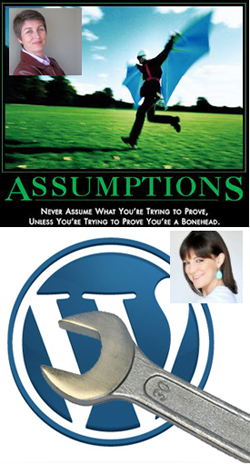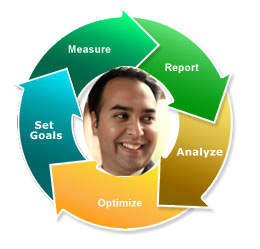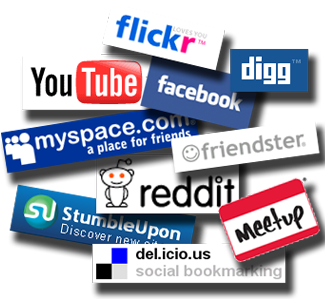Last week, as part of the Master of Arts Management Speaker series, students had the unbelievable opportunity to listen to a talk on leadership by Terre Jones, president and CEO of Wolf Trap Foundation for the Performing Arts. Terre sat down with me afterwords to discuss the importance of technology in the work done by Wolf Trap.
9 Helpful Tips to Supercharge Your Digital Marketing: A free webinar for arts marketers!
Increasing online engagement, smarter budgeting for websites, banner ads that sell, and higher return rates on fundraising appeals; if any of the above caught your eye, you must be a digital marketer! And Technology in the Arts invites you to participate in a free webinar that will help you achieve these targets and enable your organization to Supercharge Its Digital Marketing!
 The webinar, which will take place on the 7th of August (1PM EST/10AM PST), is being held in partnership with Capacity Interactive, Opera America, The League of Resident Theatres, Dance NYC, and Technology in the Arts! It will be lead by Erik Gensler, the president of the digital marketing consulting firm, Capacity Interactive. In lieu of the upcoming webinar, we decided to ask Erik a series of questions pertaining to his views around digital marketing in the arts.
The webinar, which will take place on the 7th of August (1PM EST/10AM PST), is being held in partnership with Capacity Interactive, Opera America, The League of Resident Theatres, Dance NYC, and Technology in the Arts! It will be lead by Erik Gensler, the president of the digital marketing consulting firm, Capacity Interactive. In lieu of the upcoming webinar, we decided to ask Erik a series of questions pertaining to his views around digital marketing in the arts.
Having worked in this field for many years, what is your opinion on the general state of digital marketing in the arts?
I think organizations are evolving at different paces. Some organizations made a commitment to embrace digital marketing years ago and are now reaping the rewards. I find that the most successful organizations have senior leaders that allocated resources for staffing and budgets to focus on their website, embraced social media, and used digital media. Other organizations are still operating like it is 1995. Generally, larger organizations are faced with lesser difficulty when it comes to digital marketing while smaller organizations may rely on a junior staff person doing the best they can without the resources or support from senior management.
Overall, I do think that most people in the industry know that embracing digital marketing is important. It is hard to miss all of the reports about the growth of digital ad spending and how brands and organizations are thriving on social media. But success in digital marketing requires time, financial and personnel resources, and hiring people with the right skills.
Are arts organizations keeping apace with the technologies and tools out there?
I never advise organizations to chase the latest technologies because we've seen so many trends come and go. Let the for-profit world invest and experiment and once there is a proven ROI and user base and then consider jumping in if you think it is the right fit for your organization. First, focus on the fundamentals like your website, Facebook, and banner advertising. Then, focus on tools that have proven benefits rather than chasing "the latest technologies." Finally, focus your time where the majority of your audience or potential audience is and pay much less attention to the margins.
We are pretty sure that not all marketing campaigns are created equal. So are there any arts organizations that you think are doing an excellent job with their digital marketing?
I am impressed by many museums that were very bullish about embracing social media. The Brooklyn Museum for one is very innovative and forward thinking. They've had dedicated staff to focus on the digital arena for years! A few years ago Carnegie Hall made a big investment in their digital efforts and we are seeing some really great results like their mobile apps, a new website rich with content, and clever social campaigns. I am very proud of our work with Alvin Ailey American Dance Theatre, particularly on Facebook where they have grown a really strong and engaged community.
Some organizations, such as the MOMA, publish interactive content primarily on their website while others seem to rely more on Facebook or Twitter (ignoring their website in turn). What role does an organization's website play in a world so keen on social media?
I don't think the question is one versus the other but rather, both are important. In the early days of social media, we thought it was important to drive users from the social network back to your website. But now users can have a meaningful experience with an organization on its Facebook page or YouTube channel. It's also more likely that they access content through Facebook or YouTube as opposed to a website, so sharing compelling content on these mediums is crucial.
This isn't to say the content shouldn't also be on the website. In fact, the website is often the first place users go to have an experience with an organization digitally. So an organization needs to express its identity and mission on the site, and hopefully, entice its users into a relationship. Finally, it’s important to note that the website is what will persist, not matter what the latest social media fad may be.
With so many content driven social platforms, it can be difficult for an organization to retain interest and engagement. Would some organizations be better off focusing on their website or is a Facebook/Twitter/YouTube presence absolutely necessary?
I think if you have the content it would be a missed opportunity not to share it across these channels. This does mean more work for the marketing staff but ultimately, the potential reward can outweigh the effort. Organizations can also use syndication tools that help distribute content across platforms.
While online avenues to fundraising are becoming more prevalent, organizations still cite direct mailing campaigns as most effective in terms of response rate. Do you think that crowdfunding and reaching out through social media / email will eventually render mailing campaigns obsolete?
As more and more older people go online and generations that grew up using email and social media mature, there is no doubt that digital fundraising will wax as direct mail wanes. We are certainly not at a place where I would advise organizations to fully abandon direct mail. One big benefit of direct mail is that it doesn't require opting-in so that makes it advantageous for acquisition. Emailing someone without permission is spamming. Direct mail doesn't have that limitation and I think very few arts organization are completely comfortable with online fundraising so, as of now, an education gap does exist.
In a world of tablets and smartphones, mobile marketing is one to watch for! But what are some of the opportunities and challenges unique to this medium?
Across our clients' sites we are seeing up to 30% of traffic on mobile and tablets. The first thing organizations need to do is create a mobile friendly site or build their website using responsive design so the content renders properly on all devices. One opportunity that I see is in online advertising. Since the mobile ad space is less crowded, CPMs for pay-per-click on mobile are lower than desktops and the competition for keywords is much lower. Plus if you have a site enabled for mobile you can add calling your box office as a direct call-to-action and track these calls.
The nature of digital marketing is constantly changing, what are some of the innovations that you find particularly interesting?
What I love about digital marketing is that almost everything is measurable. I think we've come a long way when it comes to measurement and attribution modeling (attributing conversion credit to marketing channels). Now the standard for most platforms is to measure click-through and view-through conversions in advertising. This is quite useful in helping marketers understand what is working and then optimizing efforts.
I really like the new Google Analytics multi-channel funnel reports which let you see all the visits and sources that a user took before the purchase. I also think Facebook has made some good innovations in their Insights and Domain Insights. Yet they still have some way to go in terms of providing one single interface where you can see how your advertising, organic efforts, and domain insights are performing together. Right now you have to search through three separate areas and download into Excel to get any customized data.
Even so, I am excited for the innovations coming around measurement and analytics!
Technology in Art and Arts Organizations: Interview with Fifth House Ensemble
Integrating technology, on any level, can be daunting for arts organizations. There are valid trepidations concerning cost and time commitments, and generally a change resistance culture. You won’t find that attitude with Melissa Snoza and the staff of Fifth House Ensemble.
Podcast Episode #77 - The Efficacy of Multimedia Arts Promotion and Best Practices for WordPress Sites
 This is the third and final installment of our series of podcasts (1 | 2 ) featuring interviews from the National Arts Marketing Project Conference.
This is the third and final installment of our series of podcasts (1 | 2 ) featuring interviews from the National Arts Marketing Project Conference.
Amelia Northrup leads off with an interview featuring Kara Larson from Arts Knowledge LLC discussing the results of a research study she recently conducted on the efficacy of using multimedia marketing campaigns to promote the arts, which yielded some surprising results - particularly in regards to promoting the work of emerging or relatively unknown artists.
David Dombrosky closes the episode with an interview featuring Ceci Dadisman from Ceci Creative discussing best practices for arts organizations using WordPress to create and manage their websites. This interview is chocked full of tips and tools for using WordPress effectively.
Cool Sites of the Episode
Google Analytics Conversion University - A series of recorded video lessons designed to teach analytics "newbies" how to maximize their use of Google Analytics to gauge their website's traffic.
WordPress Hosting on GoDaddy - Ceci recommends GoDaddy to arts organizations without their own servers and are seeking affordable web hosting for their WordPress sites.
WordPress Plug-in Directory - Plug-ins connect WordPress websites to external services (like Google Analytics) and expand the functional capabilities of your site. This directory allows you to search over 12,000 plug-ins to find the right ones for your website.
Podcast Episode #74 - Developing Your Digital Analytics Toolkit
 In this episode of the Technology in the Arts podcast, Molly Hanse talks with Michael Newberry from the Global Analytics Team at OMD, one of the world's leading companies in media communications, about measuring progress in arts organizations and how to develop your digital analytics toolkit as an arts manager. Their conversation covers analytic tools for your online communications, choosing which data to analyze, making decisions based on data analysis, determining where to invest in advertising, and more.
Cool Sites of the Episode:
In this episode of the Technology in the Arts podcast, Molly Hanse talks with Michael Newberry from the Global Analytics Team at OMD, one of the world's leading companies in media communications, about measuring progress in arts organizations and how to develop your digital analytics toolkit as an arts manager. Their conversation covers analytic tools for your online communications, choosing which data to analyze, making decisions based on data analysis, determining where to invest in advertising, and more.
Cool Sites of the Episode:
Google Analytics - It's robust. It's free. If you aren't addicted to it yet, you should be. This tool provides you with all of the basic tools you need to determine how well your website is serving your organization.
Google Insights for Search - Allows you to compare search volume patterns across specific regions, categories, time frames and properties.
Quantcast - Web analytics experts building powerful statistical technology to understand digital media audiences. Offer free and paid levels of audience analysis.
[display_podcast]
Podcast Episode #73 - Overview of PatronManager CRM with Gene Carr
 In this episode of Technology in the Arts, Brad interviews Eugene Carr, President of Patron Technology, about the recent launch of PatronManager CRM - "an all-in-one system that manages and integrates all [of an] organization's operations: ticketing, donations, correspondence, e-mail, and calendar." The conversation reveals Patron Technology's inspiration for pursuing the development of a customer relationship management system customized for arts organizations. What benefits will it provide? Can small arts organizations afford it?
In this episode of Technology in the Arts, Brad interviews Eugene Carr, President of Patron Technology, about the recent launch of PatronManager CRM - "an all-in-one system that manages and integrates all [of an] organization's operations: ticketing, donations, correspondence, e-mail, and calendar." The conversation reveals Patron Technology's inspiration for pursuing the development of a customer relationship management system customized for arts organizations. What benefits will it provide? Can small arts organizations afford it?
Podcast Episode #70 - Discussion of "Theatre & Social Media in 2009" with Devon Smith
 In this episode of the Technology in the Arts podcast, CAMT marketing assistant Pat Germann interviews Devon Smith, director of research and analysis for Yale Repertory Theatre, about her recent report "Theatre & Social Media in 2009."
Devon Smith holds an MBA from Yale School of Management, an MFA in Theatre Management from the Yale School of Drama, a Bachelors of Business Administration and a Bachelors of Arts from the University of Washington. She is a long time nonprofit manager, social media addict, and has developed a burgeoning interest in cinematography and world travel. With a voracious appetite for blogs & books, she is currently in pursuit of a fabulous, high paying, soul-fulfilling job that combines all of her interests–or, you know, anyone willing to actually hire her.
In this episode of the Technology in the Arts podcast, CAMT marketing assistant Pat Germann interviews Devon Smith, director of research and analysis for Yale Repertory Theatre, about her recent report "Theatre & Social Media in 2009."
Devon Smith holds an MBA from Yale School of Management, an MFA in Theatre Management from the Yale School of Drama, a Bachelors of Business Administration and a Bachelors of Arts from the University of Washington. She is a long time nonprofit manager, social media addict, and has developed a burgeoning interest in cinematography and world travel. With a voracious appetite for blogs & books, she is currently in pursuit of a fabulous, high paying, soul-fulfilling job that combines all of her interests–or, you know, anyone willing to actually hire her.
Read the full report (PDF 5.8 MB) >>
Visit Devon's blog: http://www.devonvsmith.com
[display_podcast]
Podcast Episode #68 - Walker Arts Center's Social Media Experiments and Tips for Email Marketing
 In this episode of Technology in the Arts, Amelia Northrup interviews Justin Heideman, New Media Designer at the Walker Art Center, about recent online projects that have propelled the Walker into the forefront of art organizations engaging their audiences through social media.
Related websites:
West St. Paul video
My Yard Our Message
In this episode of Technology in the Arts, Amelia Northrup interviews Justin Heideman, New Media Designer at the Walker Art Center, about recent online projects that have propelled the Walker into the forefront of art organizations engaging their audiences through social media.
Related websites:
West St. Paul video
My Yard Our Message
Also in this episode, Corwin Christie catches up with Patron Technology president Gene Carr to talk about e-mail marketing strategies for arts organizations.
[display_podcast]






